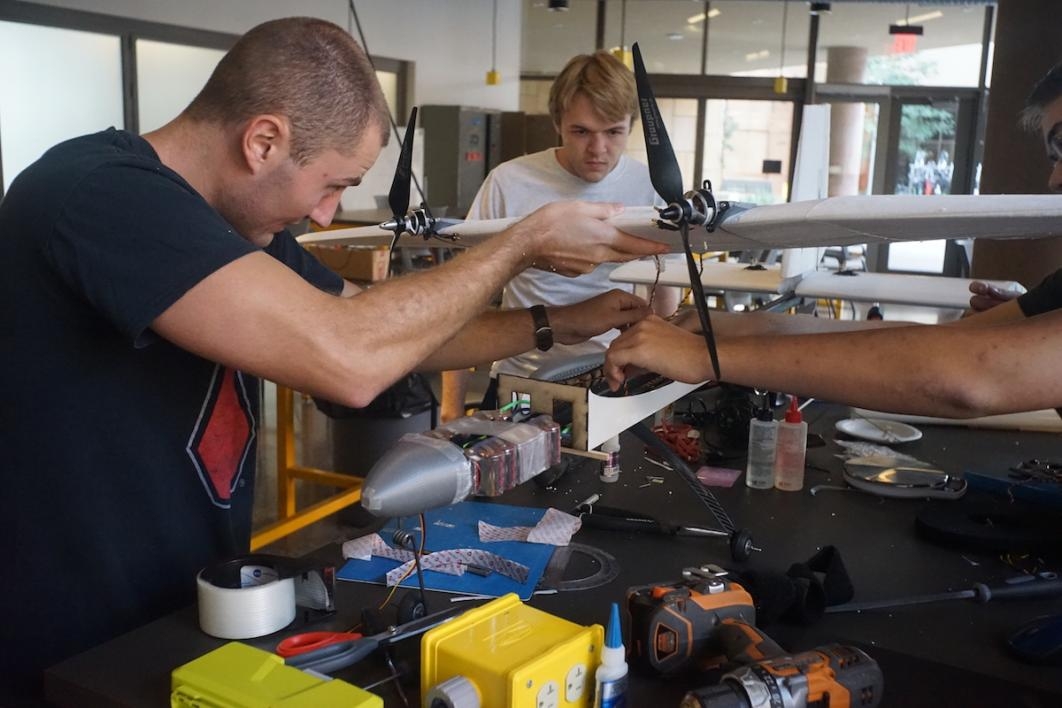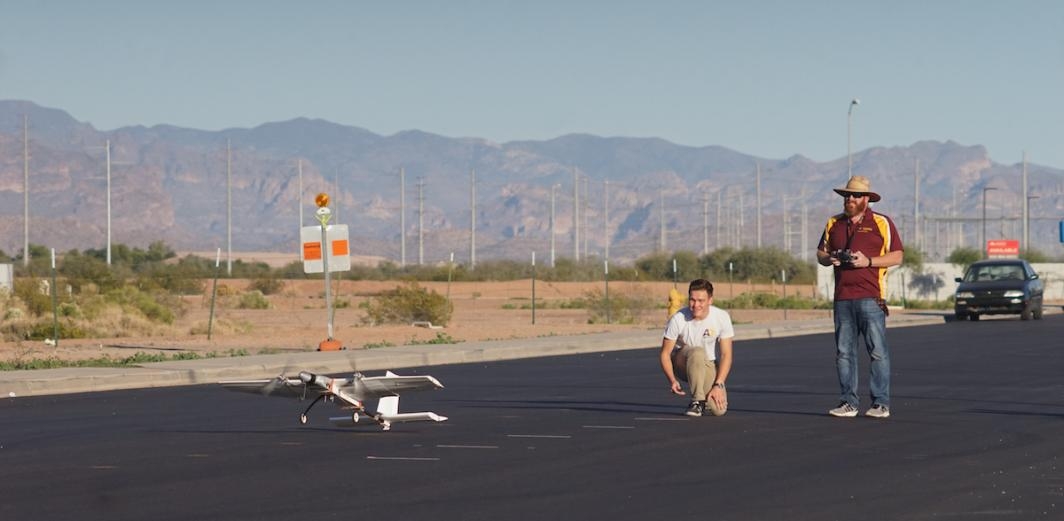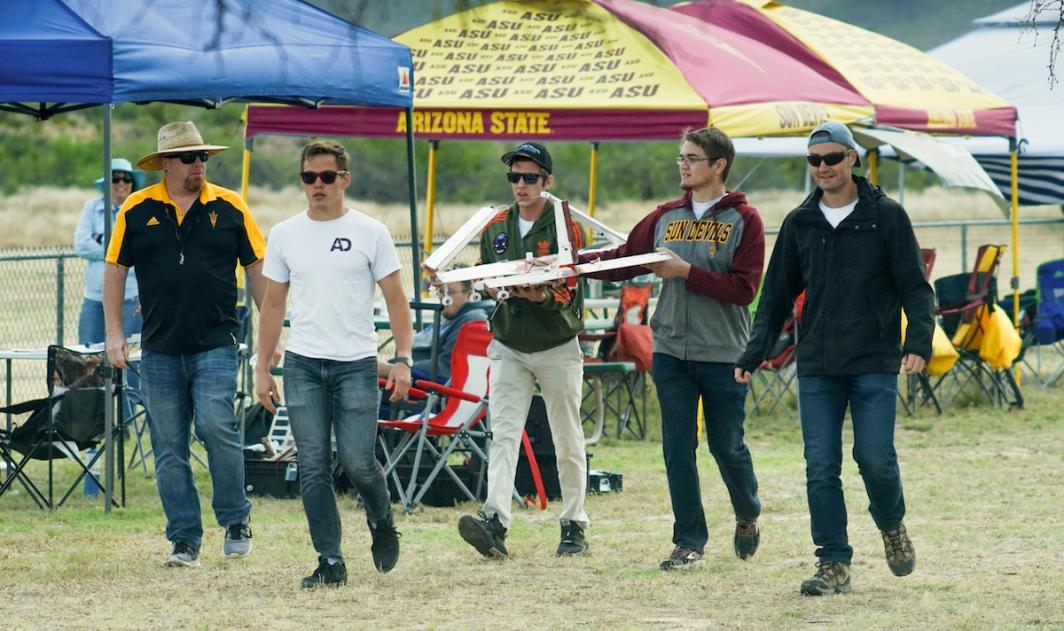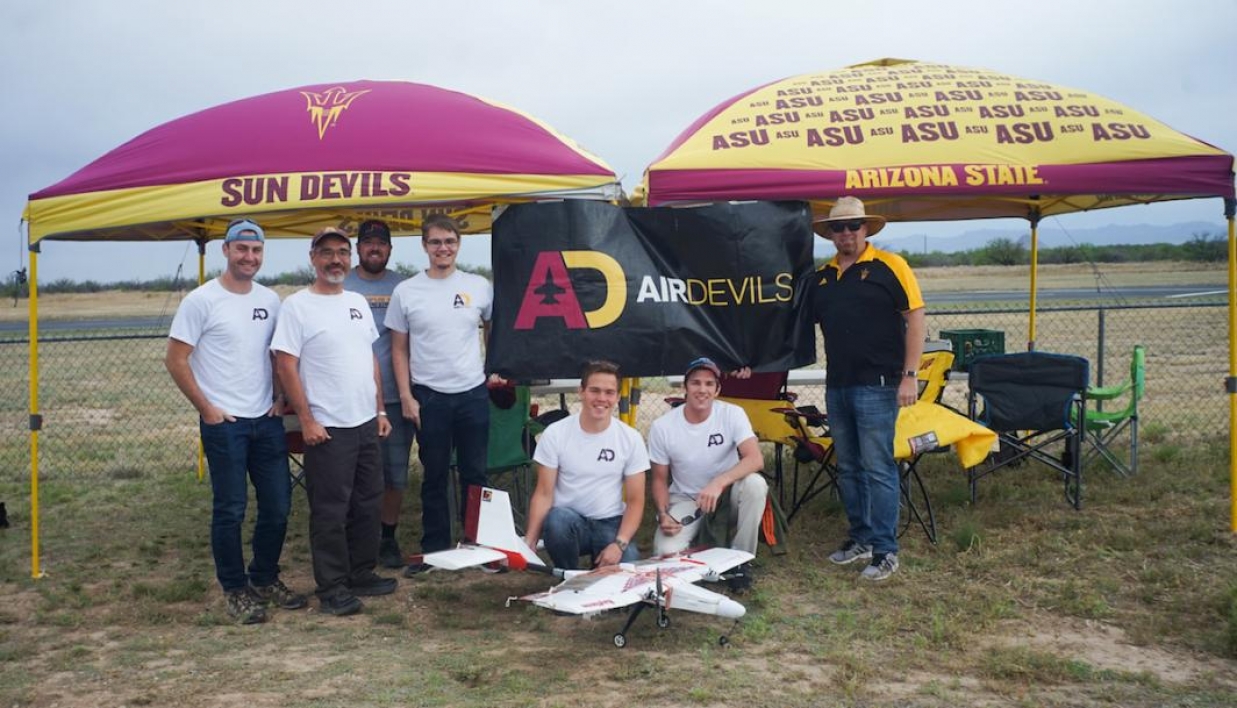ASU students take their aircraft design skills to the sky
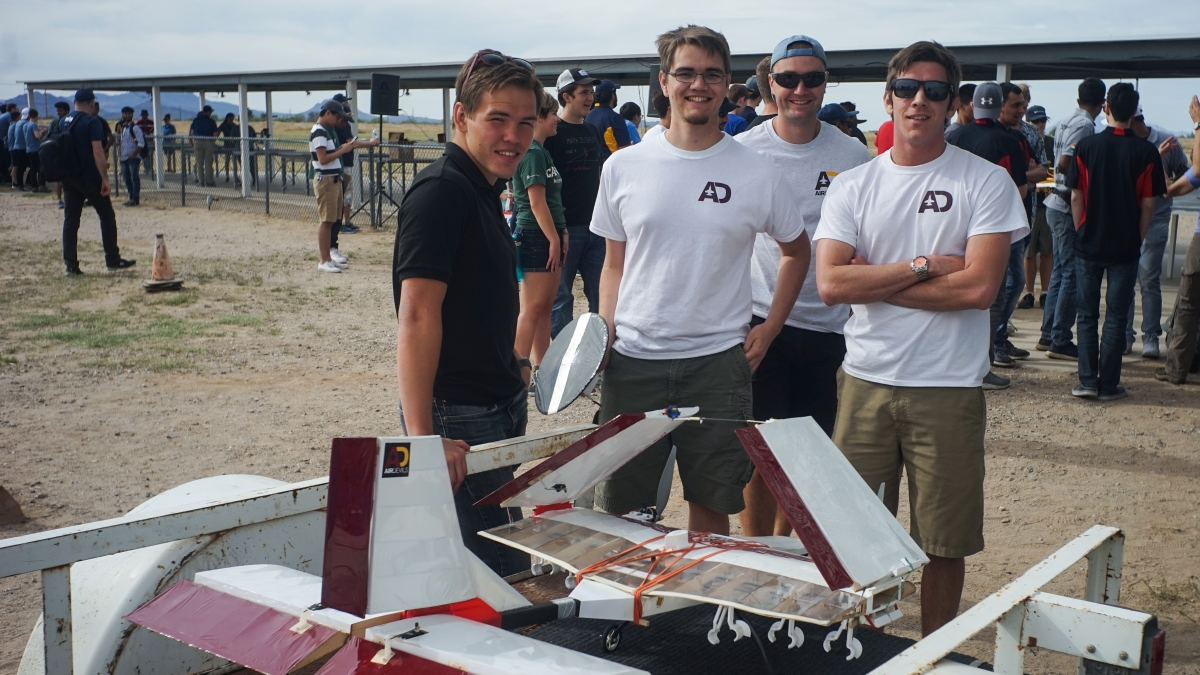
Arizona State University students (from left to right) Nikolay Kolesov, Daniel Kosednar, Luke Burgett and Evan Draganchuk competed in the American Institute of Aeronautics and Astronautics Design/Build/Fly Competition Flyoff in Tucson, Arizona. The team, which also included students from the ASU Air Devils student organization, completed all missions of the competition and placed 17th overall. Photo courtesy of Timothy Takahashi
The 38th American Institute of Aeronautics and Astronautics Design/Build/Fly Competition Flyoff challenged 785 students from six continents to perform aircraft carrier operations in the desert.
In the competition, undergraduate and graduate aerospace engineering students create small unmanned, electric, radio-controlled aircraft that meet strict requirements, develop a report about their design and complete flight missions on a new theme each year.
Raytheon Missile Systems hosted the 2019 aircraft-carrier-themed competition at the Tucson International Modelplex Park Association Airfield.
A group of Arizona State University students from the Ira A. Fulton Schools of Engineering was one of the 77 teams out of 142 total entries that participated in the final flyoff round of the competition.
The team, led by undergraduate aerospace engineering student Nikolay Kolesov along with undergraduate aeronautical management technology student Evan Draganchuk and undergraduate aerospace engineering student Daniel Kosednar, successfully completed all the missions of the competition and placed 17th overall.
The aircraft had to pass four simulated aircraft carrier ground and flight activities.
First, the aircraft needed to autonomously fold and lock its wings to pass through a 3-foot-by-2-foot box simulating a transition from the hangar to the flight deck.
Then the ASU team’s aircraft had to fly three laps of a course as quickly as possible.
Next, the aircraft donned a radome (a dome that protects radar equipment on the outside of the aircraft) for a reconnaissance flight. The radome needed to remain stationary for takeoff and landing but had to rotate during flight.
Lastly, the team took their aircraft on the offensive with a 10-minute attack flight in which it completed as many laps as possible while dropping an “attack store” payload made of foam.
Kolesov, Draganchuk and Kosednar developed the aircraft with other members of the Air Devils student organization under advisor Timothy Takahashi, an aerospace engineering professor of practice in the School for Engineering of Matter, Transport and Energy, one of the six Fulton Schools.
“AIAA Design/Build/Fly is a great experience because students have to learn how to design and fabricate hardware that works in the real world, which means it has to reliably fly in real weather," Takahashi said.
The ASU team members were diligent about getting things done early, which contributed to their success.
“With the team running ahead of schedule, we got a lot of time to work out the detail kinks in our design,” Takahashi said. “The lessons learned came from a considerable amount of successful practice flights.”
This year’s team was a relatively young one, comprised of mostly first- and second-year students, with only two third-year students. Many of them were competing for the first time and building their first competition aircraft.
“The most unique thing about our aircraft was the attention and detail we put into creating the perfect wing shape for our mission,” Kolesov said. “For all of fall semester, our flight sciences lead, Luke Burgett, worked with Dr. Takahashi to test different airfoil shapes, wing twists and thicknesses to create a design that would best suit our need. The benefits of this were clearly visible in how stable our aircraft was coming off the ramp at low speeds compared to other schools.”
Their design also helped the team take on the requirement of a short, 10-foot take-off runway of the simulated aircraft carrier. Kosednar said they “utilized the ‘wind’ generated by the propellers directly to produce lift for the wing” rather than the engine to generate forward airspeed and lift, as many other teams did.
The payload mission — in which teams could score the most points — ended up being the most challenging.
“It was extremely difficult to design a reliable payload-release mechanism in the mission rule-set,” Kosednar said, noting the payload foam missiles had shorter tails than the ones used in tests, which were less stable and would fail to release in their aircraft’s mechanism.
However, they excelled in the non-payload flight mission.
“Our first attempt was relatively slow compared to the other teams, but during our second attempt we managed to get one of the fastest times.”
Due to the large number of teams competing, there was a lot of time to chat with other competitors while team members waited to fly. It was a valuable lesson to learn how teams from other schools addressed the same design and mission challenges.
“Seeing other schools fly was a very interesting experience, mainly because it highlighted how open-ended engineering problems can be,” Kolesov said. “After working on one design for a year, you kind of convince yourself that this is the only way to solve the problem, so it’s always interesting to see how other planes in the competition are different from yours.”
Kosednar noted that every team had a different solution for each component of the aircraft, and he talked with many of them to see “how they went about their design process and how or why they chose to do certain things that our group didn’t do for one reason or another.”
In all, the team members were happy with the results, as they were just getting the hang of some of the basics of aircraft sizing, weight estimation and aerodynamic analysis.
Landing among the top 20 teams was an accomplishment, but next year, the team will aim to earn a top-10 spot for the first time in ASU’s AIAA DBF competition history.
The same team members will be back for the 2019-2020 season competition. This year, they mastered a basic design, but next year they can be more ambitious, which is the way to win, said Kolesov, an experienced competitor.
“After three years of participating in DBF, I’ve learned that you can’t win the competition by taking an approach that you know will work from the start,” he said. “The way to win is to come up with an aircraft concept that seems too ambitious to ever make it off the ground and then find a way to make it work.”
More Science and technology

Hack like you 'meme' it
What do pepperoni pizza, cat memes and an online dojo have in common?It turns out, these are all essential elements of a great…

ASU professor breeds new tomato variety, the 'Desert Dew'
In an era defined by climate volatility and resource scarcity, researchers are developing crops that can survive — and thrive —…

Science meets play: ASU researcher makes developmental science hands-on for families
On a Friday morning at the Edna Vihel Arts Center in Tempe, toddlers dip paint brushes into bright colors, decorating paper…


